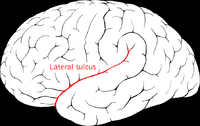
Photo from wikipedia
Opening the Sylvian fissure is an important technique in neurosurgery. Despite providing excellent anatomic fidelity, cadaveric and synthetic models lack real-time hemodynamics and coagulation physiology. We introduce a live rat… Click to show full abstract
Opening the Sylvian fissure is an important technique in neurosurgery. Despite providing excellent anatomic fidelity, cadaveric and synthetic models lack real-time hemodynamics and coagulation physiology. We introduce a live rat aortoiliac model to practice the basic skills of Sylvian fissure splitting based on its arachnoidal microanatomy. Cadaveric dissections were carried out to assess the microanatomical relationships between the Sylvian fissure arachnoid and its contents, namely arteries (A), veins (V), and brain (B). Rat surgeries were performed to assess the similarities between separating aortoiliac arteries from adjacent veins and the various technical aspects of dissecting the Sylvian fissure. The Sylvian fissure could be divided into 3 compartments regarding the progressive steps of its dissection: (1) superficial opercular, (2) deep opercular, and (3) cisternal. The major arachnoidal connections that required division during dissection of each Sylvian compartment were as follows: B-V and V-V types in the superficial opercular; B-B and A-B types in the deep opercular; and A-B and A-A types in the cisternal compartments. Dissection techniques in the rat aortoiliac model correlated with key techniques in Sylvian fissure dissection. Despite lacking brain tissue, the rat aortoiliac arteries offer a model in which the arteries and veins with their investing connective tissues mimic the arachnoid-vessel interconnections in the Sylvian fissure. Therefore, using this model simulates the essential sub-techniques of splitting the Sylvian fissure. The rat model may be used to provide trainees with an opportunity to practice under the duress of the real-time hemodynamics and coagulation physiology.
Journal Title: Journal of Clinical Neuroscience
Year Published: 2019
Link to full text (if available)
Share on Social Media: Sign Up to like & get
recommendations!